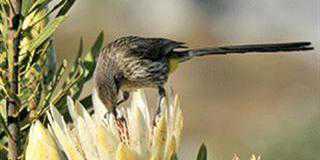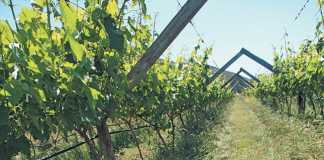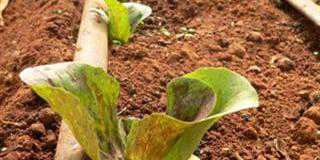During the Napoleonic wars the British blockaded cane sugar shipments from the West Indies to France. In response Napoleon decreed French farmers must plant 32 000ha of sugar beet and offered state assistance for setting up processing factories, thus giving birth to the modern sugar beet industry that today accounts for about a third of total world sugar production.
Despite favourable production results achieved during field trials in the Eastern Cape, efforts to establish a sugar beet industry in South Africa in the last decade have not taken off, largely because producers would have to compete on a global sugar beet market with highly subsidised European and American producers at a time of low sugar prices and a strengthening rand. But strategic national interest has now translated into powerful political backing and the necessary public funding likely to give the industry the breath of life it needs – with all the advantages and pitfalls this entails.
What has piqued Pretoria’s interest in the sugar beet trials being conducted in the greater Fish River Valley near Cradock is the promise of a cheap, reliable source of biofuels. In 2005 Cabinet approved an industrial strategy for biofuels aimed at creating jobs and stimulating the rural economy, especially in the former homelands, while contributing up to 75% of South Africa’s renewable energy target, in line with our commitment to controlling international climate change by reducing emissions of greenhouse gases. A biofuels task team consisting of representatives from 12 national departments, including Treasury, Agriculture and the Presidency, released a draft biofuels strategy for public comment in December 2006, proposing the mandatory blending of biofuels with fossil fuels (8% for ethanol and 2% for biodiesel). A draft strategy was presented to Cabinet in May.
Industry players are currently wrangling over incentives and licence structuring that will lure the massive investments needed for setting up processing plants. The Presidency, which has identified renewable fuels as a priority sector for the government’s Accelerated and Shared Growth Initiative for South Africa (AsgiSA), says a finalised strategy should be handed to Cabinet in June. A key concern for investors (plants will cost upwards of a billion rand) is reliability of feedstock supply – something for which Cradock’s sugar beet plantings are perfectly placed.
Two new biofuels projects
Earlier this year the Industrial Development Corporation (IDC) reportedly announced it was looking to invest R3,2 billion in two major biofuels projects, capable of producing almost 200 million litres of bioethanol, or 20% of the national target of one billion litres at an 8% blending rate. Both are at an advanced stage of technical study, with production expected to commence early in 2008. The projects are a sugar cane and sweet sorghum processor on the Blyde River irrigation scheme near Hoedspruit and a sugar beet plant at Cradock.
In the mid-1990s the Cradock-based Eastern Cape Agricultural Cooperative identified crops (such as beet) suited to contract farming that could be processed locally. Such crops have several advantages: they offer farmers price stability despite the abolition of market controls; involve a large number of producers, including emerging farmers; and ensure returns remain in the economically depressed district, thereby creating local jobs and wealth.
German agronomist Dr Volker Fischer began conducting small field trials for sugar beet in the valley nine years ago. Fischer had previously worked for chemical giant BASF’s agriculture division in California before conducting research on improving sugar beet yields on 82 collective farms in Russia.
Claims of spectacular results achieved by his trial plantings were initially met with widespread scepticism by local farmers. In Europe, the US and Russia – which together account for 80% of world sugar beet production – average yields of 50t/ha are reached, although recent trials in Australia achieved an average yield of 77t/ha, peaking at 100t/ha. But in seven years’ of trials in the valley covering different planting and harvesting dates, seed varieties, fertilisers, herbicides and growing lengths, Fischer claimed average yields well in excess of 100t/ha, with high sucrose levels.
The co-op decided Fischer had hit on the right crop for the district and formed Sugar Beet SA as a shell company to promote the concept, secure government backing and lure private-sector investment. “We were all sceptical at first – but it looks like we were wrong,” says Michael Vermaak, whose farm Van der Lindenskraal has 640ha under irrigation, making it one of the largest on the scheme. Vermaak was contracted by Sugar Beet SA for a 21ha trial and harvested in May this year. “We’ll easily get 120t/ha because we have a much longer growing season than Europe,” he says.
“Germination is tricky but once it’s up, it’s an easy crop,” he explains. “Later there will be issues with herbicides and pesticides, but in the long term we’ll get 100t to 120t/ha.” Sugar Beet SA trials included testing which varietals thrived in local conditions and their reaction to natural pests. The company will supply farmers with weed and fertiliser-coated pellet seed. Grower contracts will include continued technical support.
Land and labour issues
Vermaak says the greatest drawcard for commercial farmers is price stability. “If you know what you’re going to get beforehand it’s a huge advantage.” But he cautions that many farmers in the district are wary of an insistence on labour-intensive farming methods. “At the moment everything is done by hand, but labour is a problem in these areas. A lot of people don’t want to work because they get social grants,” Vermaak says. At present European harvesters cannot be used on Cradock’s beet because of its size, but Vermaak believes a technical solution must be found. “Harvesting will have to be mechanised for commercial farmers to support it.” He believes greater scope exists for sugar beet production in the former homelands. “This will be a good thing for the Transkei and Ciskei. It’s an easy crop to grow – the average farmer can do it.”
Getting commercial farmers to commit enough land has always been a major headache. In 1998 Reuters reported that a consortium of German and South African investors would begin building a R420 million sugar beet mill in Cradock that year, with completion expected in 2000. Funding would come mainly from the German firms Nord Zucker und Kleinwanzelbener Saatzucht and ACE Agrar Consulting, who would own a 53 % stake. The deal was dependent on sourcing 10 500ha of irrigated land – virtually the entire Fish River Valley irrigation scheme – but it eventually fell through when too few farmers were willing to commit.
But in 2003 the Eastern Cape agriculture department decided the proposal merited further investigation. A steering committee was formed that reported directly to agriculture MEC Max Mamase. It was chaired by senior agriculture official Zukile Pityi, Sugar Beet SA CEO Roak Crew, commercial farmer representative Hilton Collett and emerging farmer representative Lusapo Bengu. The department put up R10,5 million for further large-scale field trials and studies conducted by independent sugar, timber and energy consultants PGBI.
A pre-feasibility study completed in September 2004 warned that given the high cost of building a processing plant, viability would depend on government allocation of financial support, land and water – and good and reliable producer prices. A full bankable study finalised a year later confirmed Dr Fischer’s high beet and sucrose yields but gave the proposal the thumbs down. The plant needed would cost R1 billion but the strong rand, depressed world sugar prices, and having to compete against highly subsidised foreign beet producers would turn it into a white elephant. “They said to us: sorry, this is not going to fly,” says Crew. On the plus side, PGBI pointed out that production costs per unit of sucrose were among the lowest in the world. “They told us to try and find an alternative use for this product.”
According to Crew, Cradock beet’s sucrose content is 19,5% to 20%, whereas cane farmers are happy to achieve 12,5% to 13%. Sucrose is fermentable, which means it can be turned into bioethanol. With high yields, low production costs and more fermentables per ton than cane sugar, growing beet would be viable in South Africa if demand for ethanol was high enough. Late in 2004 national government launched its biofuels initiative, and Sugar Beet SA started negotiations with the Central Energy Fund and IDC. By the end of 2006 the co-op had sold Sugar Beet SA to Eastern Cape finance parastatal Uvimba, and the IDC had committed funds for a full feasibility study for building a sugar beet biofuels production facility. The study should be finalised in September, with construction starting in January 2008.
A key constraint, identified in the original research into sugar processing, will be securing sufficient land and water to guarantee an uninterrupted supply. Previously 160 farmers had committed a total of about 6 500ha of land under irrigation, leaving a 4 000ha shortfall expected to come from underutilised irrigation schemes in former homelands such as Qamata, over 200km away. The schemes, including Qamata, are beset with social conflict and uncertain tenure arrangements, making it hazardous to rely on their producers for secure feedstock supply. But as Crew points out, with biofuels only 5 200ha – about half the original area – will be needed to make a plant viable, which means the participation of the schemes is no longer a prerequisite for project approval.
To limit transport costs the company has decided on an 80km to 100km radius cut-off point for beet growers, which leaves Qamata out of the loop, although the company has set a target of sourcing 30% of feedstock from emerging farmers, which could include sourcing surplus maize from the scheme once it is fully operational. “We are creating an opportunity for them to participate. The extent to which they do will have to come out in negotiations among the communities themselves.”
Government supports on-site processing
Pityi, the agriculture official who heads the sugar beet steering committee, says available water was a primary determining factor in selecting beet sites. This made Qamata suitable for beet production. The feasibility of using a small mobile plant at the scheme is being investigated, he says. “As government our policy is to promote on-site processing. That’s what we support.”
Environmentalists and international charities are concerned biofuels will lead to deforestation and loss of biodiversity, use more energy to produce than they contain, and compromise food security. But whereas biofuels output for irrigated maize apparently hovers at just above or even below one unit of fossil fuel consumed to produce it, sugar beet promoters claim it produces seven to eight units of biofuel for every unit of fossil fuel used. Because beet can be grown in a three-year rotation with food or fodder crops such as maize or lucerne, food security won’t be affected.
Crew says at this stage the project will be entirely funded from the public purse. Critics argue that Sugar Beet SA and its parastatal partners are recklessly spending taxpayers’ money on a project that will ultimately have to rely on sourcing supply from communal lands, where tenure conflicts and ownership uncertainty have scared off private-sector investment. But Crew rejects accusations that, with the security of knowing government will bail it out, the project can therefore take unnecessary risks. “If the land issues in South Africa are not sorted out the whole country will be trading recklessly,” he says.
Crew also stresses that IDC and CEF backing depend on the project’s commercial viability, but that start-up support is essential for this fledgling industry of strategic value to South Africa. Biofuels, like our synthetic fuels industry, will contribute to a secure fuel supply less dependent on imports from volatile oil-producing regions. And that’s worth spending public money on, he says. Moreover, concerns over secure supply are exaggerated, says Crew. “Security of raw material comes from paying the farmer sufficiently well to make it economically attractive to grow the stuff,” he says. “Farmers are rational beings and will go where they get the best price.”
Nevertheless, many were led to believe they’d be offered a collective 10% stake in the processing plant and were aggrieved when informed subsequently that they were no longer part of the decision-making process on how shareholding would be structured. But for Vermaak and many other commercial farmers like him, commitment to the project hinges mostly on the price. “Once they get the factory up and running I’ll do my sums and decide.”
Contact Mike Hendrickse on (043) 748 4639.













